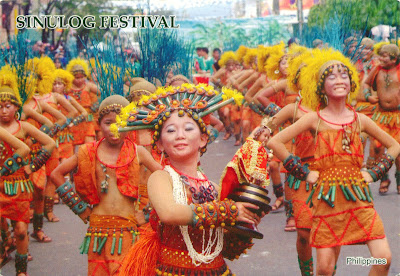April 13, 2012
0170 PHILIPPINES (Central Visayas) - Sinulog Festival
As I said here, the spaniards left to Filipinos the name and Christianity. If the name not undergone any change, the Christianity (more precisely Roman Catholicism), essentially the same as anywhere else of course, dressed forms of manifestation adapted to the local specific. Among these manifestations are traditional festivities, known as barrio fiestas (district festivals), which commemorates the feast days of patron saints, but also the pagan origin of the inhabitants. The Moriones Festival and Sinulog Festival are the most well-known. The second of these festivals, that honors the Santo Niño (the child Jesus - the patron saint of the province of Cebu), is held on the third Sunday of January in Cebu City and lasts nine days.
On April 5, 1521, Portuguese Magellan, on his journey around the world, first of its kind, has arrived on the island of Cebu, and planted the cross on the shore, claiming the territory for Spain, but even more than that, converting Rajah Humabon, his queen, Hara Amihan, and others 800 natives to Christianity. He presented the image of the child Jesus as baptismal gift to Hara Amihan, later named Queen Juana, in honor of the mother of Carlos I. At the moment of receiving the holy image, it was said that Queen Juana danced with joy bearing this image of the child Jesus, this moment being regarded later as the first Sinulog. After a few days Magellan would be killed by the ruler of Mactan, a nearby island.
In 1565, Miguel López de Legazpi arrived in Cebu and conquered the villages ruled by Rajah Tupas. In a huts of one of the burning village, a spaniard soldiers found a wooden box containing the statue of the Santo Niño lying amongst several other native idols. Historians later said that during the 44 years that had passed the natives of Cebu continued to dance the Sinulog, but no longer to worship their anitos (god) but to show their reverence to the Santo Niño. The Augustinian friars that accompanied the expedition proclaimed the statue performed miracles and built a church on the site where it was found, calling it San Agustin Church (later renamed Basilica Minore del Santo Niño).
Since 1521, devotion to the Santo Niño has grown permanently, many pilgrims making a yearly journey to the church to take part in the procession. Starting in 1980, the Cebu City government organized the Sinulog Festival and eventually gave incentives to tribal dance groups. The festival features some of the country's most colorful displays of ceremony: participants clothe in bright-colored costumes dance to the rhythm of drums and native gongs. In the 9th day, the last one of the festival, takes place a Grand Parade. The day before, the Fluvial Procession is held at dawn with a statue of the Santo Niño carried on a pump boat from Mandaue City to Cebu City, decked with hundreds of flowers and candles. The procession ends at the Basilica where a re-enactment of the Christianizing of Cebu is performed. In the afternoon, a more solemn procession takes place along the major streets.
"Sinulog" comes from the Cebuano adverb sulog which is "like water current movement," which describes the forward-backward movement of the Sinulog dance. Traditionally, the dance consists of two steps forward and one step backward, done to the sound of the drums. The dance is classified into Sinulog-base, Free-Interpretation, and recently a Latin Category, which most people have argued that it had nothing to do with Sinulog tradition. Candle vendors at the Basilica continue to perform the traditional version of the dance when lighting a candle for the customer, usually accompanied by songs in the native language.
The street parade was held this year on January 17. Seven colorful floats, depicting the seven different periods of history linking the country’s pagan past and Christian present, were accompanied by thousands of men and women in elaborately designed Philippine costumes dance their way through a planned route around Cebu City.
About the stamps
The two stamps, depicting Murex Shell (7p), are part of the set Marine Biodiversity about which I wrote here.
Sender: Toni Rose Antonio (direct swap)
Sent from City of San Fernando (Philippines), on 20.01.2012
Photo and design: Donald C. Tapan
Etichete:
AS - ASIA,
AS-Philippines,
PHILIPPINES
Locaţia:
Cebu City, Filipine
Subscribe to:
Post Comments (Atom)


No comments:
Post a Comment